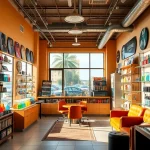The Importance of Effective Web Design
In today’s digital-first world, a website serves as the cornerstone of any business’s online presence. Effective web design is not just about aesthetics; it plays a vital role in shaping user experiences, influencing brand perception, and ultimately driving conversions. A well-designed website can differentiate a brand from its competitors, providing a seamless and engaging experience that meets user expectations. For those looking to enhance their online presence, exploring https://inkwellmarketinggroup.com/web-design can expose a variety of design approaches that cater to modern user needs.
Understanding User Expectations
Users today are conditioned to expect a certain level of quality and functionality from websites. When they land on a site, they instinctively form opinions within seconds. Understanding these expectations is crucial for web designers. Users anticipate easy navigation, rapid load times, and information presented in an organized manner. If a website fails to meet these basic expectations, users are likely to abandon it for a competitor’s site. Moreover, research shows that 88% of online consumers are less likely to return to a site after a bad experience, highlighting the necessity for well-thought-out web design.
Impact of First Impressions
The saying “you never get a second chance to make a first impression” holds particularly true in web design. A user’s first interaction with a website can determine whether they stay or leave. Studies indicate that 94% of first impressions are design-related, meaning that elements such as color schemes, typography, and overall layout can significantly influence user perceptions of credibility and value. A polished, professional design can foster trust and encourage users to engage further with the content or services offered by the site.
Mobile Responsiveness Essentials
With the increasing prevalence of mobile browsing, it is paramount that web designs are responsive. A responsive design ensures that a website functions well across different devices, from smartphones to tablets to desktop computers. Google has explicitly stated that mobile-friendliness is a ranking factor for search results, emphasizing its importance. Failure to provide a mobile-responsive experience can lead to lost traffic and reduced visibility in search engine results, thus crippling a business’s online strategy.
Key Elements of Successful Web Design
Visual Hierarchy and Layout
Visual hierarchy refers to the arrangement and presentation of elements in such a way that it leads users through a webpage effectively. It’s about prioritizing content based on importance, using size, color, and placement to direct attention. Effective layout design utilizes grid structures to create a cohesive and easy-to-follow experience. Understanding visual hierarchy not only improves usability but also enhances the aesthetic appeal of the site.
Typography for Clarity and Engagement
Typography plays a critical role in web design, influencing how users consume content. The choice of fonts, sizes, and spacing can either enhance or detract from readability. It’s essential to select typefaces that align with the brand’s character while being legible across devices. Using a maximum of two or three font styles can maintain a clean look without overwhelming the user. Moreover, adequate line spacing and contrast can further enhance clarity and engagement, ultimately keeping visitors on the site longer.
Color Theory in Web Design
Color is an influential component in web design, often used to evoke emotions and convey messages. A well-thought-out color palette not only enhances the site’s aesthetics but also can impact conversion rates by guiding user actions. Different colors can evoke different emotions; for instance, blue is often perceived as trustworthy and calming, while red can create urgency. When developing a color scheme, it’s essential to consider the audience and the brand’s identity to ensure that the colors align with the perceived message.
Best Practices for Designing User-Centric Websites
Simplifying Navigation
Navigation is crucial for any website’s functionality, serving as a map for users to find relevant information efficiently. A simple, intuitive navigation structure can significantly enhance user experience. Dropdown menus, breadcrumb trails, and a clear hierarchy make it easier for users to find what they need without frustration. Additionally, incorporating a search feature can assist visitors in locating specific content quickly, further improving the user experience.
Optimizing Load Speed
Website load speed is a fundamental aspect of web design that directly impacts user satisfaction and search engine optimization (SEO). Studies reveal that approximately 53% of mobile users will abandon a site that takes more than three seconds to load. To optimize load speed, developers can compress images, leverage browser caching, and minimize the use of heavy scripts. Ensuring a fast load time not only helps retain users but also favors higher search engine rankings, resulting in better visibility.
Utilizing Effective Call-To-Actions
Call-to-actions (CTAs) guide users on the next steps they can take after interacting with a website. Effective CTAs use concise wording, contrasting colors, and prominent placement to attract attention. Whether it’s to sign up for a newsletter, request a quote, or purchase a product, CTAs should be strategically integrated throughout the site to encourage user engagement and drive conversions. Analyzing the performance of different CTAs can provide valuable insights into user behavior and preferences.
Leveraging SEO Strategies in Web Design
Integrating Keywords Naturally
Effective web design goes hand-in-hand with SEO strategies. Integrating relevant keywords naturally throughout the site can enhance its visibility in search engine results. This includes placing keywords in headings, body text, image alt tags, and URLs. However, the inclusion should feel organic rather than forced; the primary focus must remain on providing valuable content to the user.
Optimizing Images and Media
Images and media can greatly enhance a website’s appeal but can also slow down load times if not optimized correctly. Using appropriate file formats, compressing media files, and including relevant alt text not only improve load speed but also enhance accessibility and SEO. Alt text provides descriptions for search engines as well as for users who rely on screen readers, ensuring that content is accessible to a broader audience.
Utilizing Meta Tags Effectively
Meta tags provide critical information to search engines about the content of a webpage. Properly utilizing title tags, meta descriptions, and header tags helps improve SEO performance and CTR (click-through rates) from search results. Title tags should be descriptive and incorporate relevant keywords, while meta descriptions should succinctly summarize webpage content while being engaging enough to entice clicks. Regularly reviewing and updating these tags can ensure continued relevance and optimization.
Measuring the Success of Your Web Design
Analyzing User Engagement Metrics
Measuring a web design’s success requires tracking various user engagement metrics such as bounce rates, session durations, and conversion rates. Analytics tools provide deep insights into how users are interacting with different elements of the site’s design. High bounce rates may indicate that visitors aren’t finding what they need, prompting a need for design adjustments to improve user retention. Conversely, increased session durations can signal effective engagement, suggesting that users find the content compelling.
Conducting A/B Testing
A/B testing is a valuable strategy for optimizing web design. By offering two variations of a webpage to different user groups, businesses can determine which design elements perform better based on defined objectives, such as conversions or user engagement. This makes it possible to make informed decisions about design changes rather than relying on assumptions. Regular A/B testing can lead to continuous improvement, ensuring that design elements align with user preferences and behaviors.
Continuously Improving User Experience
The web is an ever-evolving environment, and so are user preferences and expectations. Continuous improvement of the user experience (UX) is crucial for maintaining a competitive edge. This can involve gathering user feedback, analyzing user behavior, and staying updated with the latest design trends and technologies. Regularly revisiting and refining design elements based on user interactions and industry standards can help businesses stay relevant and user-focused.





